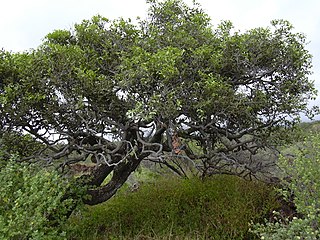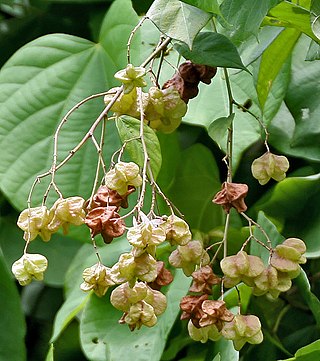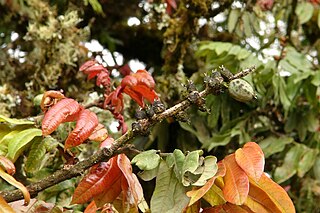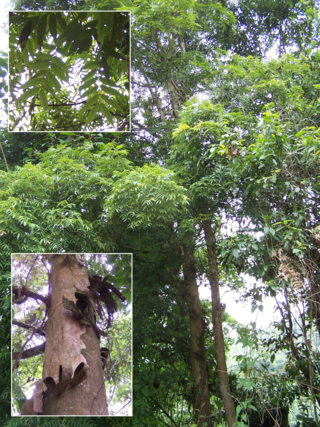
Sumac or sumach —not to be confused with poison sumac—is any of the roughly 35 species of flowering plants in the genus Rhus of the cashew and mango tree family, Anacardiaceae. However, it is Rhus coriaria that is most commonly used for culinary purposes. Sumac is prized as a spice—especially in Arab, Iranian, Lebanese, and other Middle Eastern cuisines—and used as a dye and holistic remedy. The plants grow in subtropical and temperate regions, on nearly every continent except Antarctica and South America.

Hornbeams are hardwood trees in the plant genus Carpinus in the family Betulaceae. Its species occur across much of the temperate regions of the Northern Hemisphere.

The Elaeagnaceae are a plant family, the oleaster family, of the order Rosales comprising small trees and shrubs, native to temperate regions of the Northern Hemisphere, south into tropical Asia and Australia. The family has about 60 species in three genera.

Araucariaceae is a family of conifers with three living genera, Araucaria, Agathis, and Wollemia. While the family's native distribution is now largely confined to the Southern Hemisphere, except for a few species of Agathis in Malesia, it was formerly widespread in the Northern Hemisphere during the Jurassic and Cretaceous periods.

The Ebenaceae are a family of flowering plants belonging to order Ericales. The family includes ebony and persimmon among about 768 species of trees and shrubs. It is distributed across the tropical and warmer temperate regions of the world. It is most diverse in the rainforests of Malesia, India, Thailand, tropical Africa and tropical America.

The Juglandaceae are a plant family known as the walnut family. They are trees, or sometimes shrubs, in the order Fagales. Members of this family are native to the Americas, Eurasia, and Southeast Asia.

Pterocarya, often called wingnuts in English, are trees in the walnut family Juglandaceae. They are native to Asia. The botanic name is from Ancient Greek πτερόν (pteron) "wing" + κάρυον (karyon) "nut".

Castanopsis, commonly called chinquapin or chinkapin, is a genus of evergreen trees belonging to the beech family, Fagaceae. The genus contains about 140 species, which are today restricted to tropical and subtropical eastern Asia. The English name chinkapin is shared with other related plants, including the golden chinkapins of the Pacific northwest, which are sometimes included within Castanopsis but are more often considered a separate but very closely related genus, Chrysolepis.
Carya sinensis is a species of tree native to southwestern China and northern Vietnam, in the hickory genus Carya. It is sometimes called Chinese hickory or beaked hickory. It is closely related to Carya kweichowensis.

Ostrya virginiana, the American hophornbeam, is a species of Ostrya native to eastern North America, from Nova Scotia west to southern Manitoba and eastern Wyoming, southeast to northern Florida and southwest to eastern Texas. Populations from Mexico and Central America are also regarded as the same species, although some authors prefer to separate them as a distinct species, Ostrya guatemalensis. Other names include eastern hophornbeam, hardhack, ironwood, and leverwood.

Kleinhovia is a monotypic genus of plants in the cotton, hibiscus and cacao family Malvaceae. The sole species in the genus is Kleinhovia hospita, commonly known as guest tree, an evergreen tree native to Indonesia, Malaysia and other parts of tropical Asia and the Pacific.

Vatica chinensis is a species of flowering tree in the family Dipterocarpaceae, found in South Asia.

Alfaroa costaricensis, also known as campano chile, chiciscua, gaulin, gavilán Colorado, or gavilancillo, is nut bearing timber tree in the Juglandaceae family. It is native to the Neotropics, from Mexico, through Central America to Colombia.
Alfaroa williamsii is a tropical monoecious cloud forest dwelling species of tree first recognized in the Cordillera Central of Nicaragua at an altitude of 1.3 km. The mature tree is 15–25 m in height, with a 0.5 m DBH. The sub-opposite to alternate pinnately compound leaves bear three to five opposite to sub-opposite pairs of coriaceous leaflets, glabrous above and covered with minute scales below. The pollen is born on panicles consisting of several erect catkins. The small, nearly round, glabrous, ribbed fruits are born on a sparsely flowered spike.

Oreomunnea mexicana is a species of plant in the family Juglandaceae, which grows in the tropical rain forests of Mexico, Guatemala, Nicaragua, Costa Rica, and Panama at altitudes from 1–1.7 km. Common names include guayabo amarillo and remiendo. The chromosome number is 2n = 32.
Alfaroa manningii, or gavilán colorado, is a valued lumber tree of the Walnut family endemic to the premontane Costa Rican rain forest. The specific epithet honors the American botanist Wayne Eyer Manning (1899–2004).

Engelhardia roxburghiana is a tree in the family Juglandaceae. It is named for the Scottish botanist William Roxburgh.

Bhesa indica is a flowering plant tree species in the Centroplacaceae family. It is distributed along the tropical wet evergreen forests of the Western Ghats of India. It is considered synonymous with Bhesa paniculata by some authors.

Cryptocarya anamalayana is a rare rainforest tree endemic to the southern Western Ghats, India. The specific epithet of the name refers to the Anamalai Hills, a major area of its distribution. The species considered endangered under the IUCN Red List of Threatened Species.

Diospyros paniculata, or the panicle-flowered ebony, is a species of tree in the ebony family. Endemic to the Western Ghats area of India and parts of Bangladesh, the species is currently listed as Vulnerable in the IUCN Red List.
Elliott, L. L., Mindell, R. A., & Stockey, R. A., "Beardia vancouverensis Gen. et Sp. Nov. (Juglandaceae): Permineralized Fruits from the Eocene of British Columbia", American Journal of Botany93(4): 557–565, 2006
Manchester, Steven R., "Fossil Wood of the Engelhardieae (Junglandaceae) from the Eocene of North America: Engelhardioxylon Gen. Nov.", Bot. Gasz144(1)157-163, 1983.
J. A. Vozzo (ed.) Tropical Tree Seed Manual "Part II—Species Descriptions", USDA Forest Service

















